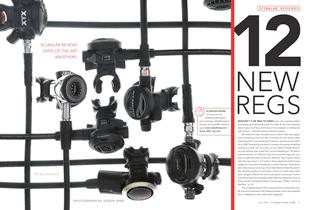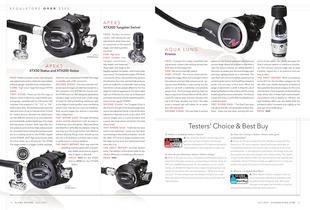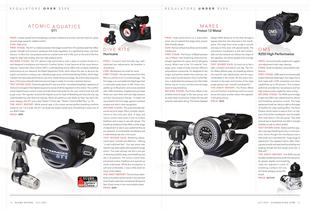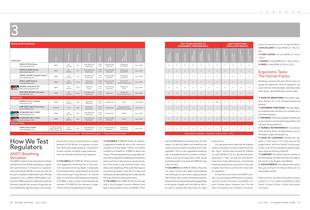
Catalog excerpts

12 S C U B A L A B ® R E V IE W E D SCUBALAB REVIEWS STATE-OF-THE-ART BREATHERS. NEW SCUBALAB ONLINE For more on how ScubaLab tests regulators, including a detailed look at REGS WOULDN’T IT BE NICE TO DEMO every new regulator before how we use the ANSTI machine, committing your hard-earned cash? It is, after all, the most important go to www.scubadiving.com/ piece of gear you’ll buy, which puts a lot of pressure on making the bonus_2007_reg_test right decision—and that’s where ScubaLab comes in. We invited all major manufacturers to submit their new regulators (introduced within the last 12 months) for this review. After inspecting them and reviewing the owners’ manuals we put them on an ANSTI breathing simulator to measure the precise breathing resistance a diver will encounter at four different depth/breathing rate settings that range from normal breathing at 132 feet to extreme exertion at 198 feet. Then we turned the regs over to a team of eight test divers to be your stand-ins. Their mission was to rate each reg using a 1 to 5 scale in seven ergonomic performance categories, from ease of breathing to comfort features. These divers also made notes on each reg—what they liked and what they didn’t like. We then polled our test divers to find out which reg in each BY BILL KENDIG price category offered the best combination of features, comfort and performance and awarded these regs the additional honor of being named a ScubaLab Testers’ Choice (see “Testers’ Choice & Best Buy,” p. 73). The complete results of all our tests are found in the charts on p. 98, and are summarized in the following reviews, which are presented here in alphabetical order within price categories. 00 SCUBA DIVING J U LY 2 0 0 7 PHOTOGRAPHY BY JOSEPH BYRD J U LY 2 0 0 7 SCUBADIVING.COM 71
Open the catalog to page 1
PROS: Perfect simulator scores; well-designed user adjustments; built-in electronic intermediate pressure gauge; reversible hose configuration. CONS: High price; large first-stage (XTX50 FIRST STAGE: These are the first regs to feature a built-in electronic intermediate pres- sure gauge, complete with an LCD screen that before every dive. The electronics also trackthe date and hours of use to indicate when it's time for routine service. Beneath the digital brain are two different versions of an over-balanced, environmentally sealed diaphragm first stage that has plenty of brawn. Both regs...
Open the catalog to page 2
ATOMIC AQUATICS PROS: Lowest overall work of breathing; corrosion resistance at a lower cost than titanium; great second-stage swivel for added comfort. FIRST STAGE: The ST1 is a balanced-piston first stage turned from 316 stainless steel that offers greater strength and corrosion resistance than brass regulators at a significantly lower cost than titanium. It offers four low-pressure ports on a swivel turret with a fifth port on the end of the first stage for easy hose routing, plus two high-pressure ports. SECOND STAGE: The ST1 delivers high performance with a dose of comfort thanks to a...
Open the catalog to page 3
PROS: Excellent performance at a budget price (MK11/R395); compact first stage; nice second-stage adjustment; smooth and dry- CON: Some bubble interference. FIRST STAGE: The MK11 first stage was the smallest of the test group but held its own, putting up some of the best test scores recorded in this review. This over-balanced diaphragm first stage features two high-pressure and four low-pressure ports, two of which are marked "HFP" for pumping out 15 percent greater air flow. Convert to a DIN connection and you have the makings of a compact tech rig. The big surprise is that the MK11/R395...
Open the catalog to page 4
REGULATOR FEATURES ANSTI Breathing The ANSTI machine is the international industry standard for scientifically evaluating a regula- tor's performance. It measures a regulator's work of breathing (WOB) in joules per liter (j'/l) for each complete inhale/exhale cycle. We test regulators at four different RMV/depth com- binations (RMV stands for Respiratory Minute Volumes, basically the amount of gas that can be ventilated through the lungs in one minute). All simulator tests are performed at a supply form well at this supply pressure, it will perform as well or better at higher supply...
Open the catalog to page 5Archived catalogs
-
SCUBALAB REVIEWED 18 New Fins
6 Pages



